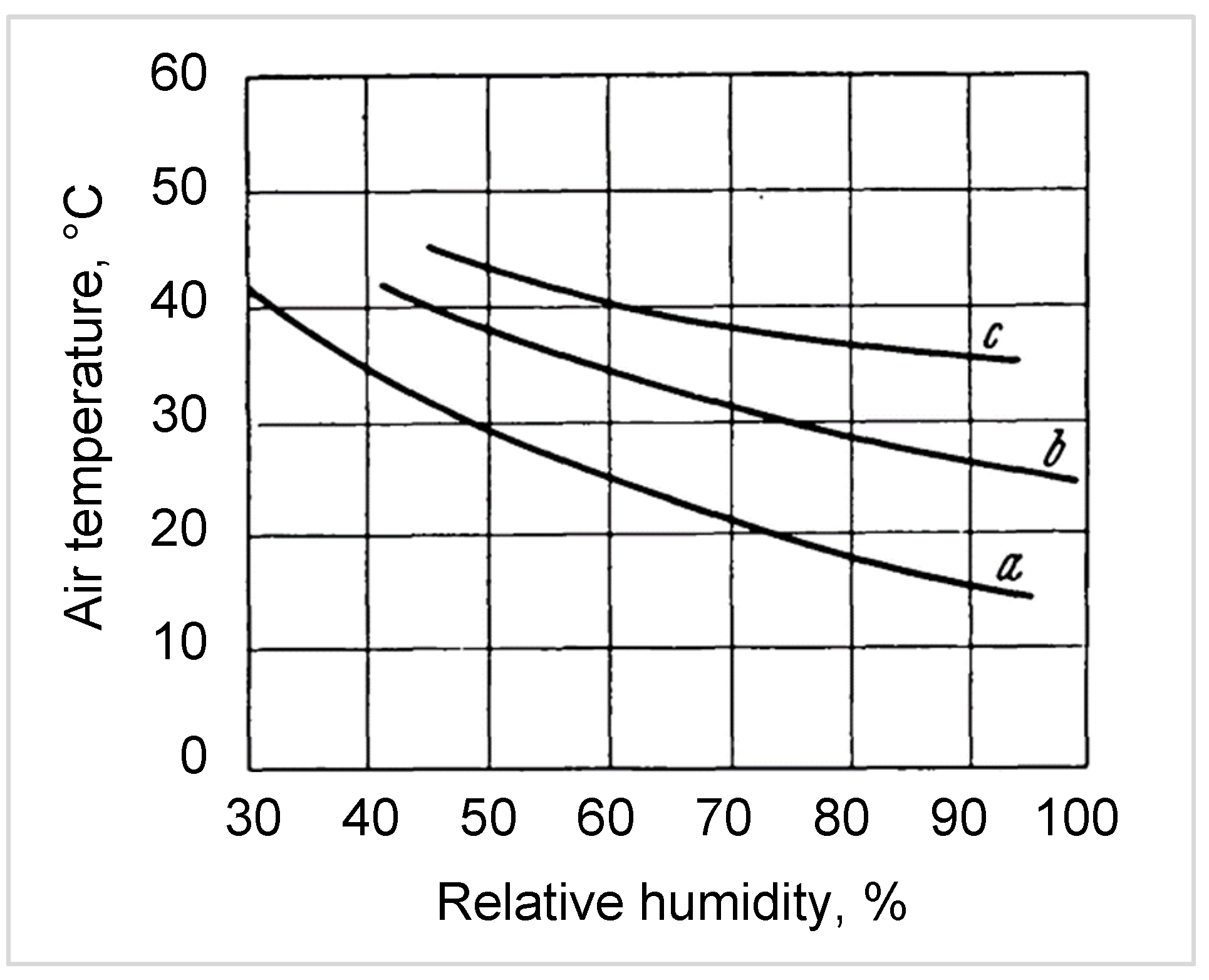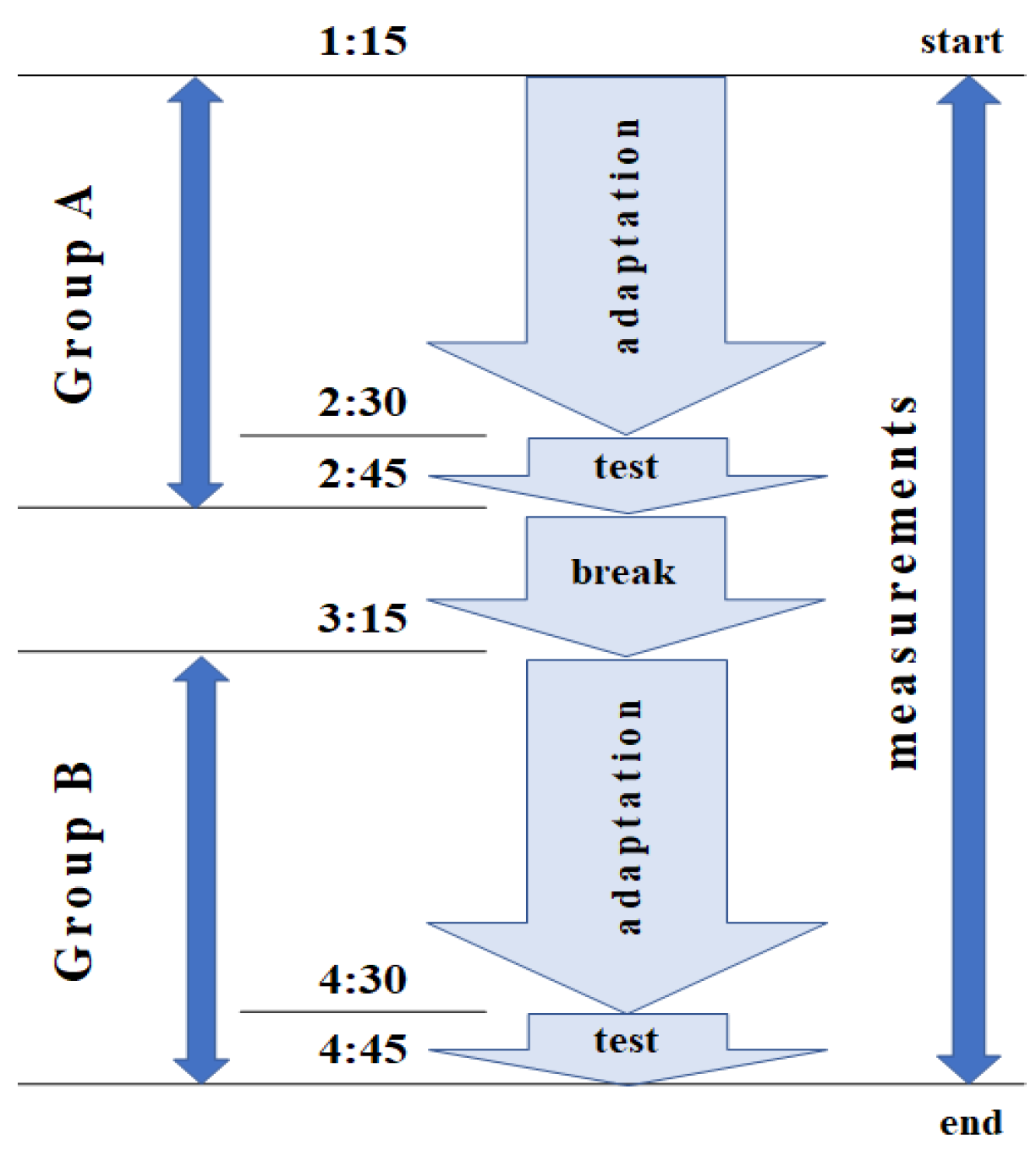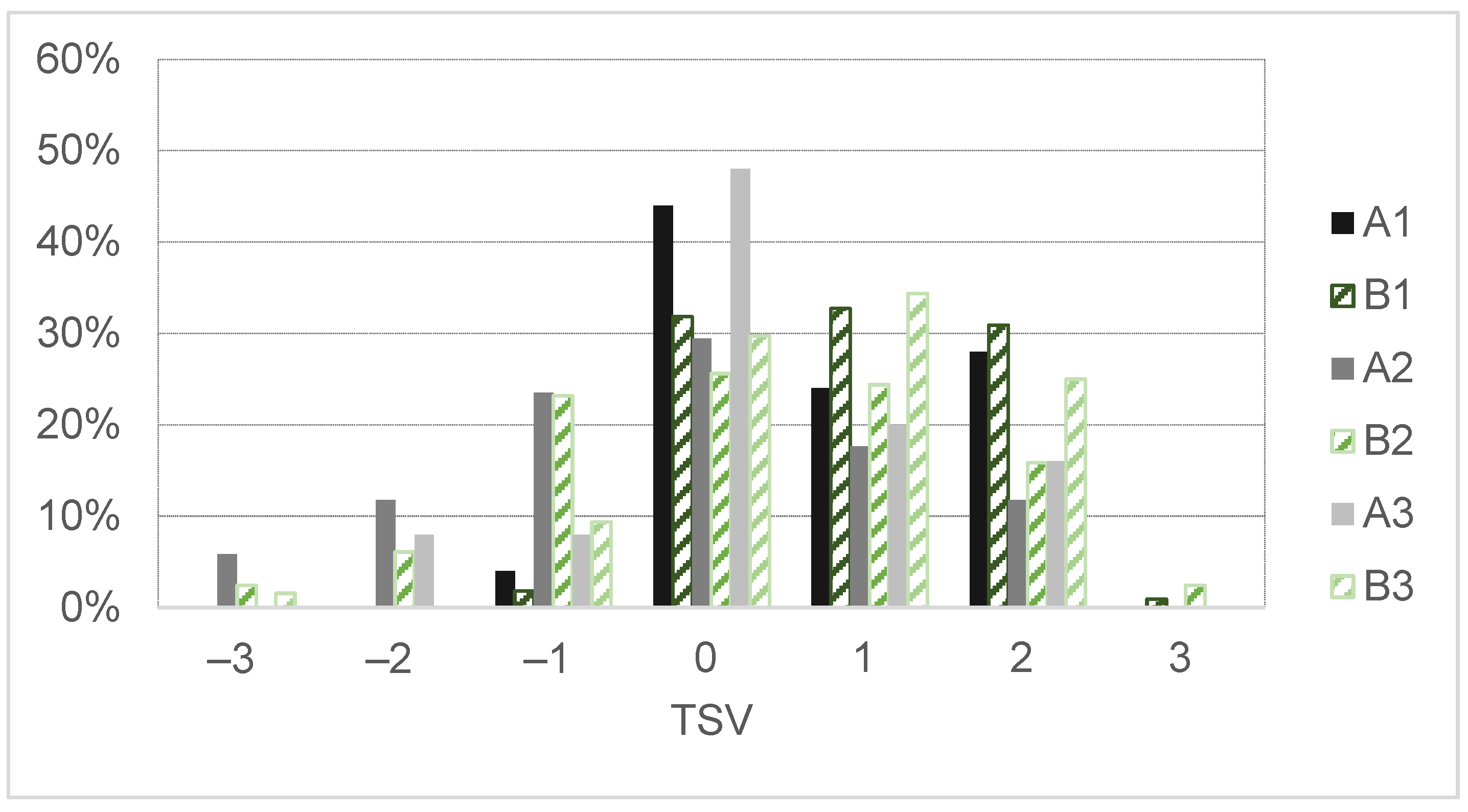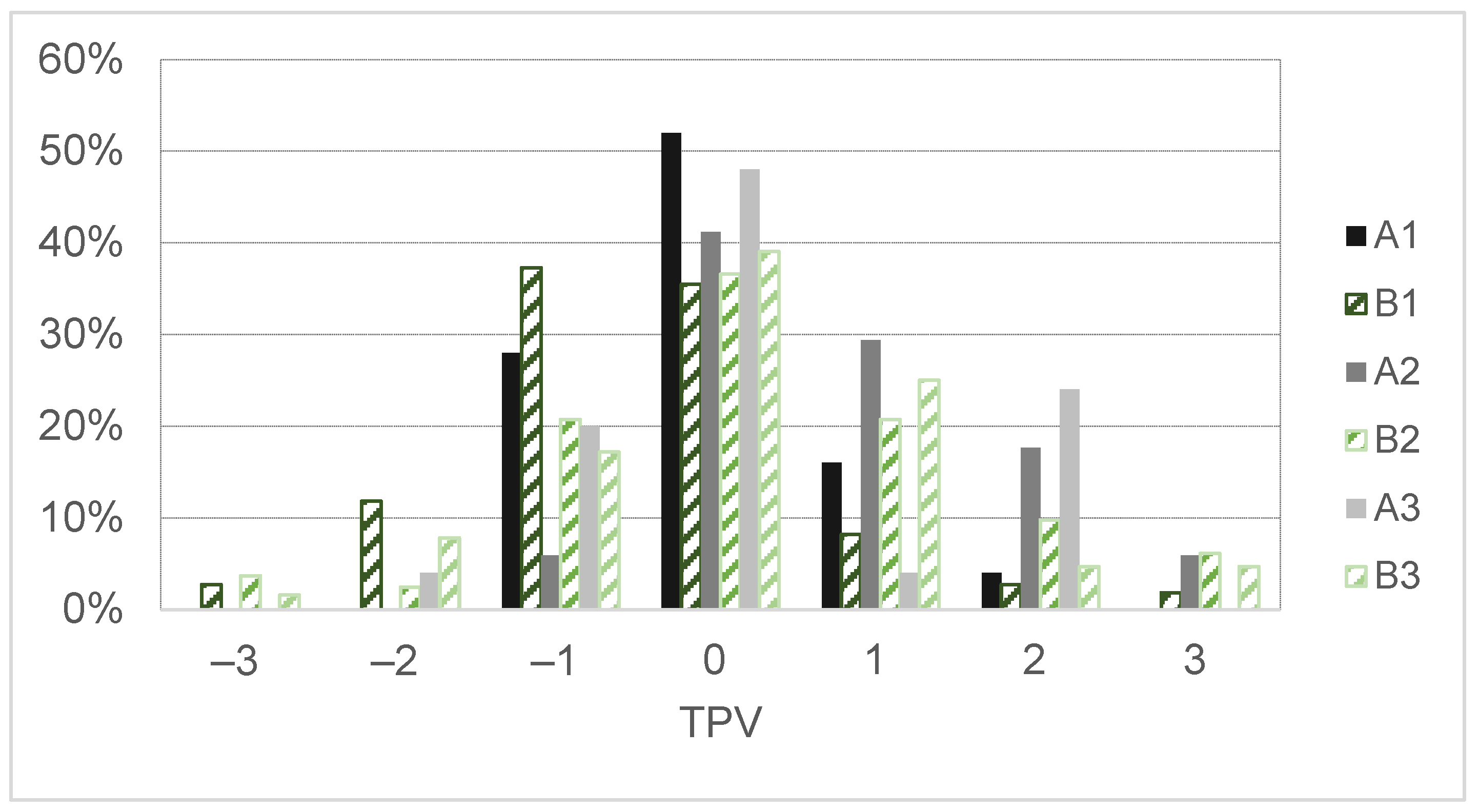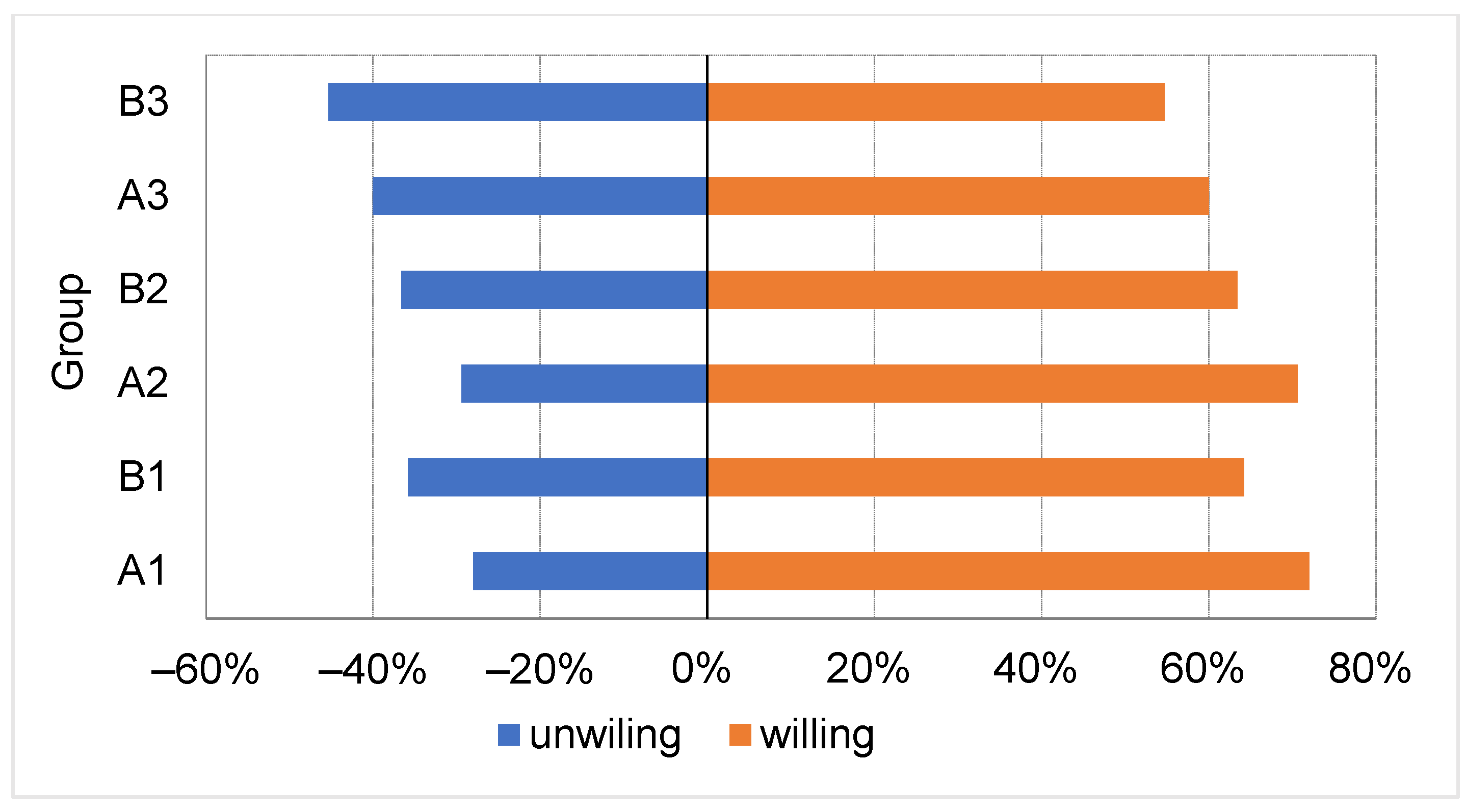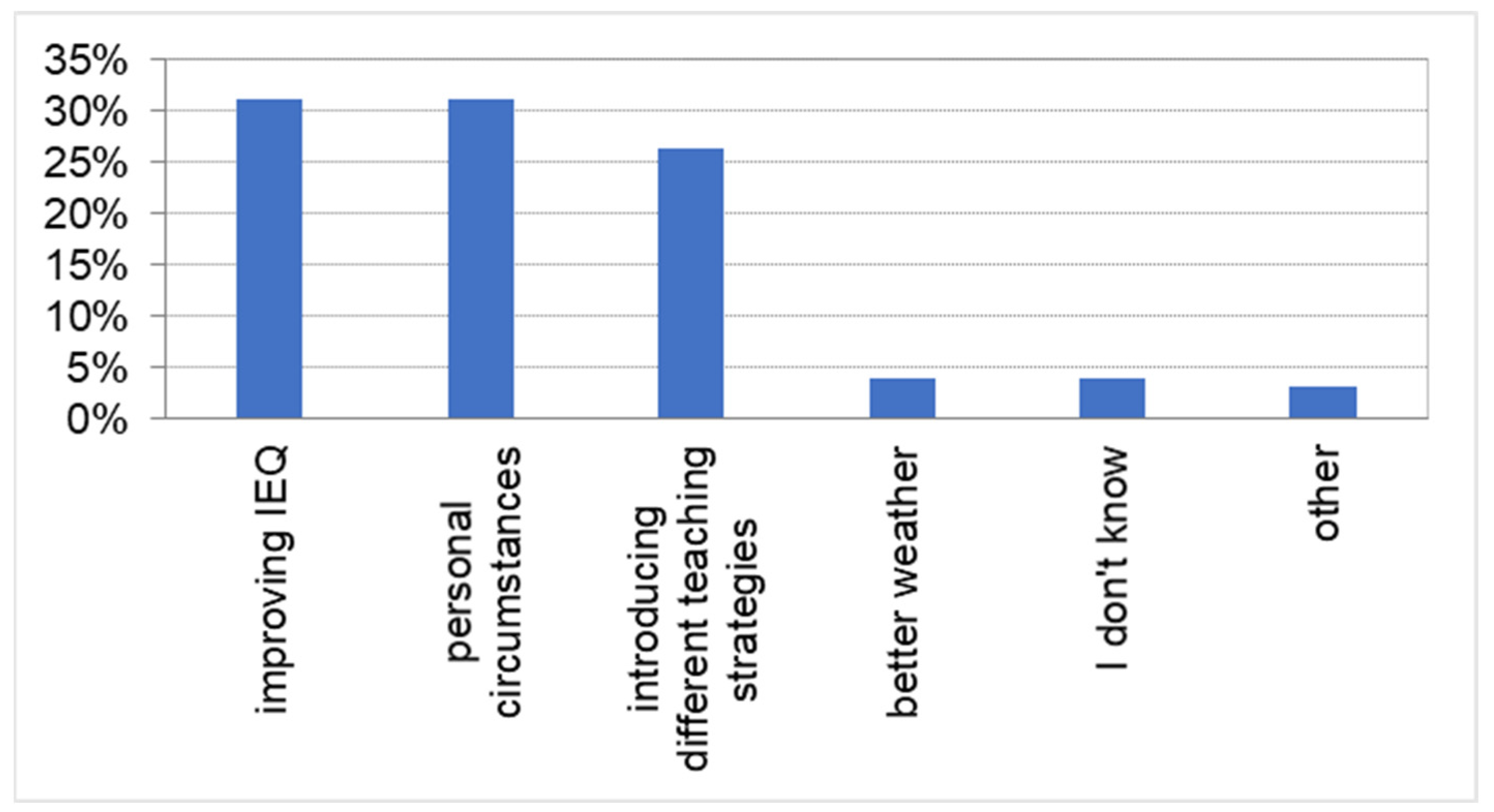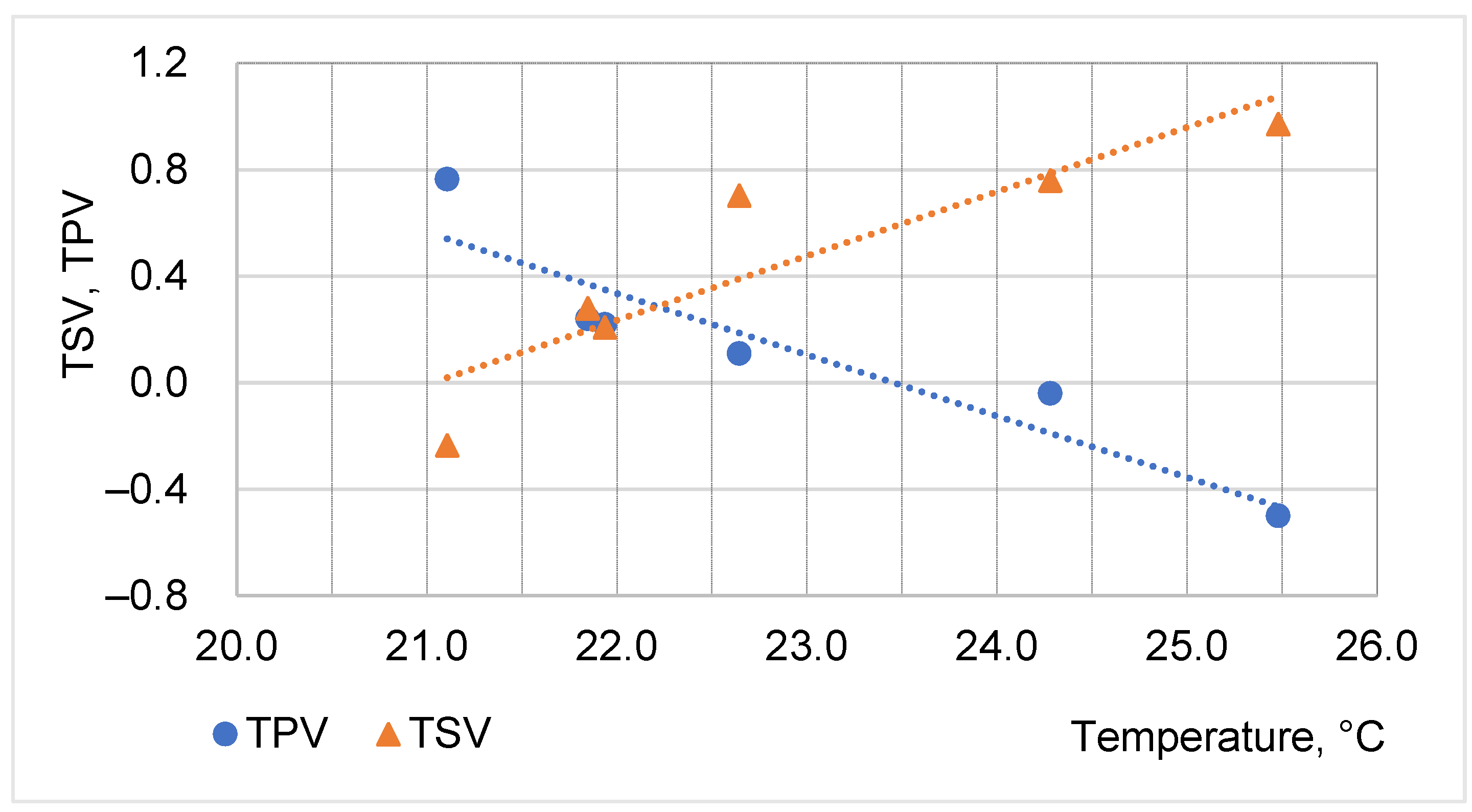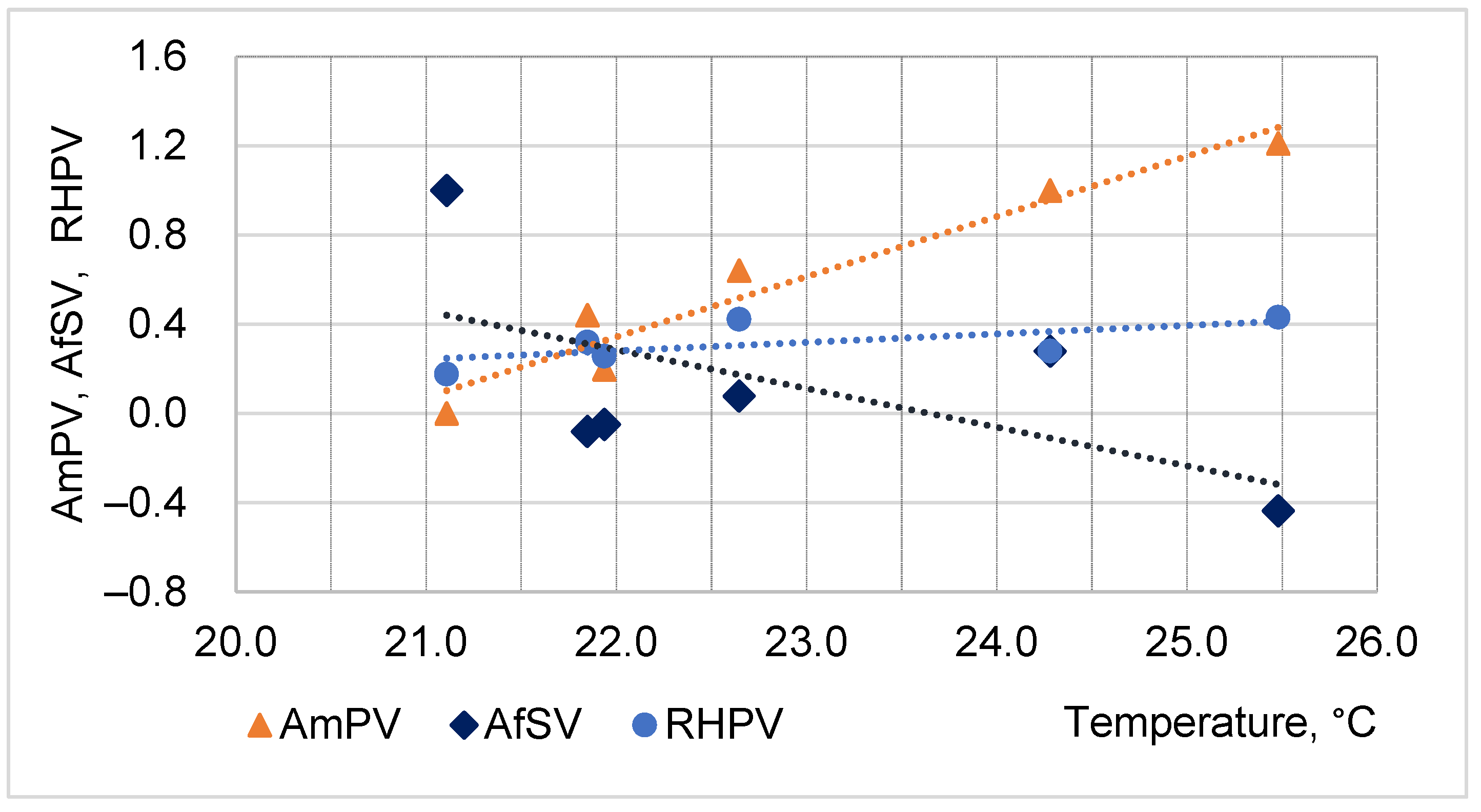1. Introduction
Today, when analysing buildings, especially in the context of climate change and the approaching energy crisis, solutions are desired that lead to lower energy consumption. However, at this point the thermal comfort of the building users cannot be omitted. The influence of occupant behaviour is as important as the quality of the building envelope [
1], therefore, the goals of reducing energy consumption in buildings will not be achieved without taking into account knowledge of occupants’ preferences and potential behaviour. When constructing new buildings from scratch, it is easy to implement all available and sophisticated solutions leading to energy savings. When existing buildings are considered, such improvements are not as easy to implement. The literature [
2,
3], International Energy Agency (IEA), European Council (EC) reports and documents [
4,
5,
6,
7] indicate that these buildings represent a significant potential in energy savings when simultaneously thermal comfort is one of the key elements influencing energy consumption [
8].
In Poland, existing buildings, both residential and public utilities, are mostly naturally ventilated, equipped only with radiators, without any cooling system. In such constructions and implemented solutions, the main actions to maintain adequate internal conditions internal conditions (desired by users) internal conditions are opening or closing the windows and controlling temperature by using thermostatic heads or room thermostats. Building users’ behaviour, if they do not pay for the energy consumed (e.g., in workspaces) [
9], is focused primarily on assuring their individual thermal expectations and overall well-being conditions and are leaning towards options that they perceive to be the most efficient in terms of providing comfortable thermal conditions without any awareness on energy efficiency issue [
1]. Additionally, most of the users do not have a sufficient and proper knowledge about the correct level of comfort parameters, and thus their actions are focused on answering their actual comfort needs. Such situation, if not controlled would lead to excessive energy use, because of as frequent changes of temperatures in room.
Differences in users’ thermal perceptions could be related to their expectations of indoor environmental quality and may be higher in green or certified than in traditional office buildings [
10,
11,
12,
13]. Individual thermal comfort may also differ from the traditional approach to thermal neutrality defined in standards [
14]. The indoor conditions of the human work environment and educational buildings are widely described in the literature [
15,
16,
17,
18,
19,
20,
21,
22] also for different locations around the world [
23,
24,
25]. A school indoor environmental quality investigation reported that 64% of the tested classrooms did not meet the thermal comfort conditions and inadequate ventilation in some classrooms resulted in high concentrations of carbon dioxide (CO
2) [
26]. Thus, there is still a need for research on the influence of indoor environmental quality on students’ sensations in air-conditioned and naturally ventilated classrooms at universities with the special emphasis on understanding of human perceptions and users’ behaviours impact on building energy usage [
23,
26,
27]. The relevance of motives and preferences can be illustrated by the rebound effect, e.g., in the case of residential renovation measures [
1], where occupants maintain higher indoor temperatures after thermal upgrading and thus reduce the expected savings. Although the main factor influencing behaviour prior to renovation measures must have been the reduction of energy costs, increased energy efficiency has minimised the importance of this factor in favour of another: the desire for comfortable thermal conditions. It must be understood that thermal comfort is an individual sensation and is strictly related to energy efficiency of the building and human satisfaction from the indoor environment. The way in which users actively promote or passively accept higher comfort levels determines the effectiveness of measures to increase energy efficiency and reduce CO
2 emissions [
1]. However, the sensations described by standard indices do not go in line with real needs of the occupants, or the occupants cannot define them correctly due to problems with understanding the chosen comfort variables influencing human sensations. Therefore, there is a problem to find a solution that merges these aspects that are placed on two opposite poles. Nevertheless, creating healthy and desired indoor conditions is always in priority over reducing energy consumption [
6,
28]. One of the methods to assess the users’ perception and individual preferences in terms of thermal comfort is questionnaire survey. The presented paper is based on such a study carried out in the naturally ventilated lecture room.
The purpose of the article is to show that the preferences of indoor conditions of users can differ significantly from each other and are not always in line with the scientific interpretations and definitions of thermal comfort scales. Therefore, it must be considered if the layperson can control the indoor environment and maintain energy consumption at a low level at the same time. The authors’ purpose is also to determine the students’ willingness to work and subjective factors affecting it, as well as their well-being during the lectures.
2. Sultriness
One of the factors that influence well-being of the people inside the buildings is the level of sultriness caused by the high temperature and relative humidity [
29]. As will be demonstrated in the following part of the article, it is the most difficult issue for respondents to recognize. Thus, in this chapter, a brief theory of the concept of sultriness is presented.
The upper limits of relative humidity for the sensation of thermal comfort at a specific temperature were indicated by Lancaster (1898) and presented as a graph, which later became known as the Lancaster-Castens sultriness curve [
30]. The graph of the sultriness curve is shown in
Figure 1.
The curve defines the boundary of sultriness with respect to temperature (T in °C) and relative humidity (RH in %). What is interesting, it indicates that the sultriness does not occur at temperatures below 16.5 °C even if the relative humidity reaches 100% [
30].
This curve has been approved by many researchers, while the distance from the stuffiness border is described by the Equation [
31]:
If D is equal to 0, the parameters express the sultry border, while positive values of D in the Equation indicate sultriness area. Some discrepancies can be noted between the values calculated and determined from the chart (
Table 1).
When the parameters of the room are in the zone of stuffiness, the warm air inhaled by a person is not able to cool the body through the process of convection and evaporation. At high air temperatures, relative humidity determines the intensity of sweat evaporation. In general, dry and cool air is perceived as fresh and clean. On the other hand, air with the same chemical composition and degree of pollution, but with a higher temperature and humidity, gives the impression of being stale and stuffy [
32]. Bad thermohumid conditions can cause dizziness, a feeling of shortness of breath, or weakening of the body.
5. Analysis and Discussion
5.1. Temperature
As mentioned in the introduction, the thermal comfort, as well as energy saving aspects, strongly depend on internal temperature. Higher temperature means higher energy use in heating season, so it is important to evaluate the neutral or preferred temperature, which would be satisfying for users but not too high (for energy saving purposes).
One of the most popular methods for estimating the neutral temperature is the linear regression of Thermal Sensation Votes (TSV) and indoor air temperature (T
a) or operative temperature (T
o). The linear regression equation describing the relation between TSV and T
o for the investigated study in the naturally ventilated lecture room is defined as follows:
The calculated coefficient of determination amounts R
2 = 0.82 (
p < 0.005) and indicate the strong relationship between T
o and TSV. The neutral operative temperature calculated according to Equation (2) for the described study is 20.97 °C. This value is generally lower than the mean operative temperatures estimated during the previous studies, listed in
Table 6 [
45,
46,
47,
48,
49,
50]. In the same auditorium, the authors conducted thermal comfort research in the spring semester. Then the calculated neutral operative temperature equalled to 21.88 °C [
50] and was thus higher than for the winter and transition period. Cena and de Dear [
45] had similar observations, they calculated a neutral winter temperature of 20.38 °C and 23.30 °C in summer (
Table 6). This is in line with the shaping of the lower and upper limit of comfort temperatures presented in
Figure 4 in relation to free-running and heated buildings, as well as to the variability of mean running external temperature. This could lead to the idea, that by making the internal temperature dependent on mean running external temperature could result in higher energy efficiency and in keeping users satisfied with conditions when compared to maintaining constant higher room temperature.
It is important to note that in many publications the ‘neutral’ answer was pointed out that it is not always the preferred option [
14,
23]. The latest research [
12,
51] indicates that the classical approach, that assumes that the answers on a 7-point scale should not be equally distanced and three middle answers should not be interpreted as comfort conditions. Furthermore, the methods to assess comfort conditions widely used by engineers, based on standards EN ISO 7730 and ASHRAE 55, are oversimplified. This approach fails to provide thermal comfort conditions in a built environment [
12]. The confirmation of this statement is the outcome of the current research. It indicates that, when the mean room temperature was 21.1 °C (group A2) and thus higher than neutral calculated from Equation (2), more than 50% of the respondents claimed for warmer conditions (mean TPV = 0.76). The relationship between TSV, TPV, and T
o for all research days and groups is presented in
Figure 13. One can observe that the respondents indicate a temperature of about 24.0 °C as the upper limit of comfort conditions (TPV ≈ 0) and only at a temperature of 25.0 °C they start to claim for slightly cooler conditions.
An interesting issue is that during the winter season the design temperature for heating system sizing and energy calculations (according to EN12831) is 20 °C. This value is lower than the one preferred by the students. This indicates that on daily basis utilisation, the building may consume more energy than at it was designed and initially predicted. The aim of user behaviour and preferences studies is, among other, to bridge the gap between predicted (based on simulation) and actual (based on observation) energy consumption [
1].
5.2. Freshness, Movement and Humidity of Air
The next important parameters of comfort conditions are air movement and air freshness [
52]. During the whole research the measured air velocities reached very low values (
Table 4), because the auditorium is naturally ventilated, and thus suffers from the lack of proper air movement. The students’ preferences regarding the air movement (AmPV) consequently, throughout the whole study period, reach the values above zero almost in the entire temperature range (
Table 5).
The relationship between AmPV and operative temperature is presented in
Figure 14 and is described by the equation:
The lowest mean AmPV equal to 0 occurs simultaneously with the lowest operative temperature of 21.1 °C (group A2). When room temperature is the highest (25.5 °C, group B1), the mean AmPV is also the highest and equals 1.2.
The relationship between AmPV and TSV is presented in
Figure 15. Most polls are placed in the first quarter of the chart, which means that with the growth of TSV, the need for air movement increases. Although AmPV is clearly correlated with operative temperature and TSV, the relationship between temperature T
o and AfSV is not so clear (
Figure 14). The correlation coefficient did not confirm a strong statistical relationship. Generally, the lower the air freshness (AfSV), the more people declared the need for better room ventilation (AmPV). Furthermore, a similar trend can be observed showing the dependence of air freshness on the percentage of occupants demanding for cooling. When the mean AfSV = −0.44, 52% of students request cooler conditions (
Table 5). The more air is perceived as fresh, the less people desire the room to cool down. This, together with the high level of higher temperatures’ acceptance in the transition period, rises the possibility that increasing the air exchange intensity (increasing air velocity) could delay the need to switch of cooling in rooms with air conditioning, and thus lead to energy savings.
Additionally, when room temperature is high, the air is assessed as stuffy (mean AfSV ≈ −0.44) but, when the room temperature is the lowest, the air is assessed to be fresh (mean AfSV = 1.0) and simultaneously the mean AmPV is the lowest (0.0).
The only way to control air movement in a naturally ventilated auditorium is to open and close the windows. In extreme cases, draughts (DR index according to EN 7730) causing thermal discomfort may occur locally. In the case of natural ventilation, it is extremely difficult to determine the amount of entering outside air and to control the energy consumption associated with its heating [
53,
54,
55]. In order to improve air quality, it is recommended to increase the air change rate in the room. If ventilation rate is higher the electric energy use will also be higher [
56,
57]. Users of the buildings often have to choose between several behavioural options to achieve their goal. Such a goal could be, for example, to reduce thermal stress or increase air quality [
1].
A further observation of the results of the questionnaires showed that regardless of the level of room relative humidity and whether the indoor conditions were perceived stuffy or not, the students demanded indoor air to be more humid. The authors were surprised by the RHPV index. On the day when the air humidity was 47% and the air was rated the stuffiest (group B1, AfSV = −0.44), up to 45% of the students requested an increase in the air humidity in the room, and only 10% a decrease in the relative humidity (
Table 5). On the other hand, on the last day of measurement, when the air was quite dry (RH = 26.0–28.5%), fewer people expected an increase in humidity than on the stuffiest day. Simultaneously in all groups, only 8 to 18% of people expected the air to be drier. This may indicate a lack of students’ understanding of the physiological, natural cooling system of the human body, and a strong need to change the air conditions in the room due to their general malaise and poor air quality. For estimating relative humidity preferences in accordance with temperature T
o the linear regression was determined. It is shown in
Figure 14, and the equation is as follows:
The relationship between the variables is not strong and statistically insignificant, because R2 = 0.49 and the p-value is equal to 0.12. Thus, the authors sought to clarify this doubt.
5.3. Sultriness
Following
Table 5, the subjective assessment of the hygrothermal conditions by students from groups B1, B2, and A3 indicated that the air during the survey was perceived as excessively stuffy, i.e., the AfSV index was negative. Therefore, air quality was assessed in terms of sultriness. Based on Equation (1) the distances from the sultry curve were determined. The results for the parameters of indoor and outdoor air are presented in the
Table 7. For all groups, the D values are negative, which means that according to Equation (1), the air parameters in the auditorium during the surveys were within a non-sultry zone. However, for group B1, which rated air as the most stuffy (AfSV = −0.44), the distance D is the smallest and amounts to −0.32. At the same time, the parameters of the outside air were also close to the sultry curve and the distance D for the time of the experiment was the smallest (−0.8).
The correlation between AmPV and the distance from the sultriness curve (D) and between AfSV and D was examined (
Figure 16). The smaller the distance in negative values of D (the air is stuffier), the greater the preference for increased air movement. Although the correlation coefficient is not high (R
2 = 0.53) it indicates a good trend in understanding the need for changes in indoor conditions. On the other hand, in the case of the feeling of air freshness/stuffiness in relation to the parameter D, it can be concluded that based on the students’ answers, such a correlation does not exist, as the R
2 coefficient was 0.05. This shows a problem of understanding the phenomenon.
5.4. Regressions
Following the aforementioned observations, the authors aimed to find the relationships between analysed indices: TSV, TPV, AfSV, AmPV, RHPV, and indoor air parameters. The results are collected and presented in
Table 8. The relationships between AfSV, AmPV, and D are also given in the table. The correlation coefficients (R
2), indicating the strength of the relationship between the parameters, and the statistical significance coefficients
p are also provided.
For regression equations TSV, TPV, AmPV and To the relationships between the variables are strong and statistically significant. Whereas in the case of AfSV and RHPV regressions are not statistically significant. The lack of correlation in these two cases may indicate: (1) the dependence of sensations of sultriness and moisture preference on other factors or (2) the misinterpretation and misnaming of sensations and needs in the context of the indoor environment. Further investigation by the authors was undertaken, because knowledge of the factors influencing the sensation of stuffiness and the need for changes in relative humidity of the room air would make it possible to provide internal conditions (IEQ) suitable for students’ work and ensure control of energy consumption at a reasonable level.
Analysing the first assumption, an attempt was made to determine the influence of CO
2 concertation. A previous study by the authors [
35,
50] showed that for building users and their perception of the microclimate CO
2 concentration is considered the key parameter for man-made air pollution.
Table 9 presents the levels of CO
2 that may cause health problems [
58,
59].
The acceptable CO
2 level in rooms is 1400 ppm (1000 ppm above the external concentration) or defined by the WHO is 1500 ppm. During the first day of measurements, after the lecture of group B1, despite the low share of room occupancy (
Table 2), the air temperature and the CO
2 concentration were high (25.78 °C and 1668 ppm, respectively). This indicates problems with the room ventilation. On each test day, the CO
2 concentration in the B group was significantly higher than the concentration in the A group, which is due to the number of people attending the lecture and again shows the poor performance of natural ventilation in the lecture room. The results demonstrate that changes in carbon dioxide concentration could influence student satisfaction with the indoor environment, which is also confirmed also by the work of other researchers [
16]. Additionally, it was observed that the feeling of stuffiness was the highest when the CO
2 concentration in the room was the highest (
Table 4). Similar observation that the air quality is perceived as stuffier as CO
2 concentration increases was noted by Gupta and Howard [
60].
Taking into account the fact that not only temperature and humidity can influence the sensation of sultriness by room users, the authors decided to perform a multiple regression analysis, taking into account more than one parameter that can influence this phenomenon. Three basic parameters that affect the sensation of sultriness: T
o, RH and CO
2 concentration were tested, the distance from the sultriness curve (D
in) was included in the analysis, as well as the inverse of the operative temperature included in the Equation for the distance from the sultriness curve. The results of the analysis are summarized in
Table 10.
It can be seen that compared to the linear regression using operational temperature (R
2 = 0.336) or only D value (R
2 = 0.049), the multiple regression gave better results in terms of the strength of the relationships (
Table 10). The most complicated Equation (e) is characterised by the highest regression coefficient, but adjusted R
2 (0.115) indicates that the amount of variables is excessive. This is also confirmed by cases (a) and (c), where the relationships are also strong and the adjusted regression coefficients are also higher than in case (e). However, the analysis of the statistical significance revealed that none of the regressions is significant and thus cannot be used to predict the users votes based on the measured conditions. The analysis of multiple regression led the authors to support the statement of users’ misinterpretation and misnaming of sensations and needs in the context of the indoor environment.
5.5. Students’ Subjective Factors
Following the literature [
17,
18,
61] it was found that air temperature can affect perception of well-being and willingness to work. It was interesting for the authors to know if the students are aware that their perceived room conditions affect their motivation to work. The questions about willingness to work were related to the concept of adaptive strategy. The most significant negative influence can be observed in warm conditions (above 25 °C). Productivity decreases proportionally with the increase in air temperature [
61] and in the range of 25 °C to 30 °C it can change by 2% per every 1 °C [
17]. In comparison, lower temperatures do not significantly differ from neutral conditions in this aspect [
18], which is visible in the present research. The survey indicates that over 55% of all respondents (
Figure 10) declare willingness to work. On each test day, in the less numerous A groups, the willingness to work was higher than in the larger B groups. The literature confirms that the temperature range of 21.0–25.0 °C is a stable range for office productivity [
17], which is clearly seen in current research. However, the exact influence of temperature on willingness to work is difficult to define in such a narrow range of the experiment: from 21.1 to 25.5 °C (
Table 4). The additional purpose of the question was to find the factors, important for respondents, that could motivate them more to work. The received responses were divided into 6 categories: improving Internal Environment Quality (IEQ), personal circumstances, introducing different teaching strategies, better weather, I don’t know, other. In the context of this article, the most relevant category is improving the IEQ as shown in
Figure 11, which includes answers related to improving air quality (increase in air movement, humidity, cooling, share of fresh air), improvement of indoor lighting intensity (especially daylight) and acoustics, more comfortable seats and benches. Among all responses, 33% indicated a desire to improve IEQ, and these factors were as important as personal factors, that is., eating, drinking, relaxing, sleeping.
The next aspect related to indoor conditions are health factors, whose influence is discussed in [
20]. The literature review indicates that health symptoms including earache and ear related, eye related, nose related, sore throat, or cough, and headache are the most common symptoms reported by students [
61].
Headache is defined in the literature as one of the most common reasons for absenteeism among students [
61]. In the present research, this symptom was reported by 18% of them (
Figure 12).
Mucus nose and throat problems were an important health syndromes that affected the students. They companied on irritating of throat, nose and eyes—even up to 76% in group A1. It could be caused by high indoor temperature (24.3 °C), but what is interesting, at the same time, these health syndromes seem the students not to affect their willingness to work.
General fatigue was declared by about 55% of the students, they also pointed out problems with concentration. These ailments reported by students are consistent with somnolence and influence on well-being.
Somnolence has a high rank on the list of subjective factors affecting willingness to work by students. As high as 63% of the occupants pointed out that they felt somnolence during class hours (
Figure 12).
Previous study of the authors and numerous publications [
50,
61,
62,
63] indicate that it is impossible to establish a clear relationship only between temperature and well-being while ignoring subjective human factors. However, the authors [
15,
17,
18] indicate that lower temperatures are better for studying environment leading, at the same time, to a lower energy consumption by the building. Furthermore, the dependence the willingness to work of human factors and personal circumstances create a complex, difficult to describe and to measure issue that is strictly related to indoor conditions and thus energy consumption by the building. This research indicates that all of these aspects are still not sufficiently recognized and need further research.
6. Conclusions
Research concerning students’ sensations and preferences in the context of maintaining energy savings in existing public utility buildings were conducted and described. The survey, undertaken at Wroclaw University of Science and Technology in Poland, during three chosen days: at the beginning, in the middle and at the end of the winter semester, indicated that the indoor conditions were in range providing thermal comfort in accordance with the subject matter. Based on 323 collected questionnaires filled by first-year students (average age 19.5 years), it was found that indoor conditions were assessed partially in a way that was predictable for the researchers, but partially the responses surprised the authors and forced them to search for answers to the doubts that arose.
For the assessment of students’ sensations and preferences 7-point scales were used, with neutral sensation described as zero value. In addition to the traditionally known TSV and TPV indices, AmPV was used to assess air velocity preference, AfSV for freshness and RHPV for humidity preference.
Calculated neutral temperature for transition and winter (heating) period was lower than temperature estimated in former research undertaken for the same auditorium in spring semester. Similar difference between seasons is described also in literature. The research confirms the statement that the neutral temperature is not perceived as a comfort one. In the described research its value of 20.97 °C was estimated by the regression line and assessed by the students as too low. Simultaneously the comparison of TSV and TPV defined by respondents indicate that the surveyed groups recognize correctly their thermal sensations, i.e., TPV decreases with the increase of TSV. This proper understanding is important in terms of achieving reliable results in context of thermal comfort and energy saving. However, the room temperature required by users, higher than the design regulation’s value of 20 °C, results in higher energy consumption. What is important, the literature indicate that to rise the work effectiveness among students, the lower temperatures are required. It is not confirmed by the research, were the highest willingness to work was observed in the group with the mean room temperature of 24.28 °C. Such a high discrepancies indicate the need for further research especially when the aspect of energy consumption is considered. During the whole research the measured air velocities were achieving very low values and thus the students indicated the need for increasing air movement, and as a result in five groups AmPV were positive. The preferences of change in room temperature are strongly related to the opposite change of air movement. Low ventilated rates and need for high velocities are significant issues in naturally ventilated rooms. The simplest solution is to close and open the windows. However, this leads to lack of the control of energy needed to heat incoming air and thus increasing dynamic heat losses.
As the air in the three groups was rated as stuffy, the room indoor conditions were assessed following the equation determining the distance from the sultriness curve. The calculations did not confirm that the indoor conditions were in the stuffiness zone according to the Lancaster-Castens curve. However, according to the interpretation of the students’ needs, for some of them fresh air was related to relative humidity, hence they preference to increase the humidity on the day with the highest measured air humidity.
The students’ indication of air as stuffy get the authors to search for appropriate correlations. However, assessment of the relationship between AfSV and RHPV from To did not indicated on a statistical significance, which presumably could have indicated the dependence of students’ sensations and preferences on other factors.
The importance of the CO2 level in the room was investigated and it was found that during the lecture of group B1, when the air was rated as the most stuffy, the CO2 concentration was higher than the values recommended by WHO, namely 1668 ppm. This indicates the importance of proper ventilation system and its role in maintaining thermal comfort and indoor air quality. However, it should be noticed that natural ventilation is more energy-consuming than a mechanical ventilation systems.
Five regression equations were found between AfSV and other parameters. The analysis of the statistical significance revealed that none of the regressions is statistically significant and thus cannot be used to predict the users votes in the measured conditions. This led to the conclusion that the word “stuffy” is misinterpreted and misnamed by students.
According to the students’ subjective assessment, they are aware that the conditions in the room may be the cause of their malaise and unwillingness to work. In order to improve indoor environmental quality and maintain rational energy consumption, the need for thermal comfort must be addressed with a complete picture, by an expert who will consider all air parameters and including CO2 concentrations. The requests for changes in relative humidity levels is inadequate for the conditions inside the room and the possibility for users to individually adjust the room parameters can lead to a deterioration of the quality of the conditions and not only increase energy consumption but also waste.
Improving energy efficiency in existing naturally ventilated public buildings is extremely challenging. Better understanding of occupant behaviour in existing buildings will help to reduce the so-called prebound effect which describes the discrepancy between the calculated and the actual energy consumption before thermal upgrading which leads to false expectations of energy savings [
1]. Meeting the thermal comfort needs of occupants and the lack of air exchange control at the same time requires a comprehensive approach. Building control or control strategies need to be based on an advanced understanding of user preferences and behavioural patterns. The study confirms the statement of Gram-Hanssen, cited in [
1] that the issue is not whether to focus on technological efficiency or on user behaviour, but how to combine both in the most sensible and user-oriented way to improve energy efficiency in the building sector.
Appropriate education among the youngest generations could contribute to a change in the perception of the issue of importance of inner environmental quality on their well-being and productivity. The presented results of the surveys and their analyses can be used for cognitive specialties.

